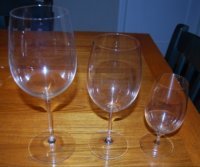|
|
All About Wine Tasting Glasses
 Choosing appropriate wine tasting glasses for your tasting or wine dinner is almost as important as picking good wines! A poor wine glass can destroy your chance of evaluating a fine wine as much as great glass can highlight its qualities. While choosing wine glasses for your own wine appreciation at home gives you the flexibility to buy several types of wine glasses specific to each style of wine, at a wine tasting you can rarely realistically have enough specialized wine glasses for all your guests. Here we will give suggestions about types of wine tasting glasses to focus on and some tips on how to make sure you have adequate stemware for your next tasting party. For more information about choosing wine glasses and the different types of wine glasses that are ideal for specific types of wine see our Choosing Wine Glasses page.
- What Makes a Good Wine Tasting Glass?
Traditional wine tasting glasses have a bowl which is big enough to have a good sized pour that only fills about 1/4 of the glass, leaving ample room for air and so that the wine can be swirled. They generally have a tulip-type or similar shape and taper together towards the top as pictured in the glasses above. This helps focus the aromas towards your nose and makes swirling easier. Good tasting glasses are also clear, without patterns, etchings or color so that you can see the wine clearly. They should have a relatively smooth edge to sip from, without the excessively rolled edge that some cheaper glasses have. Some decorative wine glasses are completely inappropriate for tasting fine wine. For example, many are colored or etched. More importantly, some glasses taper outward (similar to a Martini or Margarita glass). While these may look nice, they are completely wrong for tasting wine. The aroma gets lost in a wide mouthed glass like that and don't even try to swirl of your wine will go everywhere!If all else fails, be sure to buy glasses made by a maker who specializes in making wine tasting glasses. The most popular and widespread by far are from the Austrian company Riedel (pronounced like needle). They make dozens of different styles for different types of wines. They also have several different lines, varying in price and quality. Their entry level glasses can be quite inexpensive but still very good for basic tasting (there has recently been a cheap line introduced specifically for sale at Target stores). Their standard crystal glasses are the Vinum line, which are machine made but nice, big glasses. The top of the line is the Sommelier series which are all hand-blown. These are amazing glasses that truly capture the essence of each type of wine. They tend to be quite large in size. In the picture above you can see the Bordeaux glasses (for full bodied red wines like red Bordeaux, Cabernet and Merlot) in the Sommelier line (left) and Vinum line (middle) as well as a small glass I like for basic tasting called the Gourmet glass (right). Other brands that make excellent wine tasting glasses include Spiegelau and Shott Zwiesel. If you can find them, the standard glass used by the INAO (a wine institute in France) is a great all purpose and small wine tasting glass. - Smaller But Appropriate Glasses Work Best at a Wine Tasting
While you want to find glasses that highlight the specific type of each wine, having several different styles of glasses for one tasting is often not logistically feasible. More likely you will have several of the same type of glass for all the wines you taste. For this reason, wine tasting glasses are generally best smaller glasses that can be used for many types of wine. However, always stick to true wine tasting glasses that are contoured in a way that allows easy swirling and sipping. The smaller glass pictured above on the right is an excellent choice for a standard, all-purpose wine glass.Most glasses chosen for wine tastings are small, but not tiny, so that pours do not have to be very big and several glasses fit on the table in front of each guest. How many do you need? This obviously depends on the number of guests, the number of wines being served, and how you plan to organize your tasting. For example, most tastings are done in "flights", a number of wines served at the same time so that guests can make head-to-head comparisons and go back and forth. A flight can be anywhere from 2 to 6 or more wines. When done, you then move on to another flight. If you have less glasses, smaller flights may be necessary. Generally, you pair wines with something in common. So, for example, if you have two wines from the same producer, or same vintage, etc., then those would be paired together in the same flight. - Ask Your Guests to Bring Wine Tasting Glasses
If your wine tasting or dinner party is casual, amongst friends who are in on the fun spirit of the thing, there is absolutely no problem in asking people to bring their own tasting glasses. Most people don't have dozens of wine glasses so if you are serving many wines or have many guests, having them bring their own glasses can be a solution. Each guest may then have different types of glasses, but that is ok. Occasionally wines will show quite differently from different glasses so this can be an opportunity for you all to try the same wine from different glasses and see the effect glass size and shape can have on aromas and flavors. - Rent from a Party Rental Company or Wine Shop
If you and/or your guests don't have enough good wine glasses for your tasting or dinner, consider renting glasses. Many party rental supply companies rent trays of wine glasses. Make sure to ask or look what types they have first to be sure they are adequate. Also, call wine shops in your area as some also rent out trays of good tasting glasses.
For more info about finding good wine glasses and specific glasses for types of wine, see our Choosing Wine Glasses page.
Done learning about Wine Tasting Glasses?
Return to the How to Serve Wine page.

|
|
|
 Choosing appropriate wine tasting glasses for your tasting or wine dinner is almost as important as picking good wines! A poor wine glass can destroy your chance of evaluating a fine wine as much as great glass can highlight its qualities. While choosing wine glasses for your own wine appreciation at home gives you the flexibility to buy several types of wine glasses specific to each style of wine, at a wine tasting you can rarely realistically have enough specialized wine glasses for all your guests. Here we will give suggestions about types of wine tasting glasses to focus on and some tips on how to make sure you have adequate stemware for your next tasting party.
Choosing appropriate wine tasting glasses for your tasting or wine dinner is almost as important as picking good wines! A poor wine glass can destroy your chance of evaluating a fine wine as much as great glass can highlight its qualities. While choosing wine glasses for your own wine appreciation at home gives you the flexibility to buy several types of wine glasses specific to each style of wine, at a wine tasting you can rarely realistically have enough specialized wine glasses for all your guests. Here we will give suggestions about types of wine tasting glasses to focus on and some tips on how to make sure you have adequate stemware for your next tasting party.






